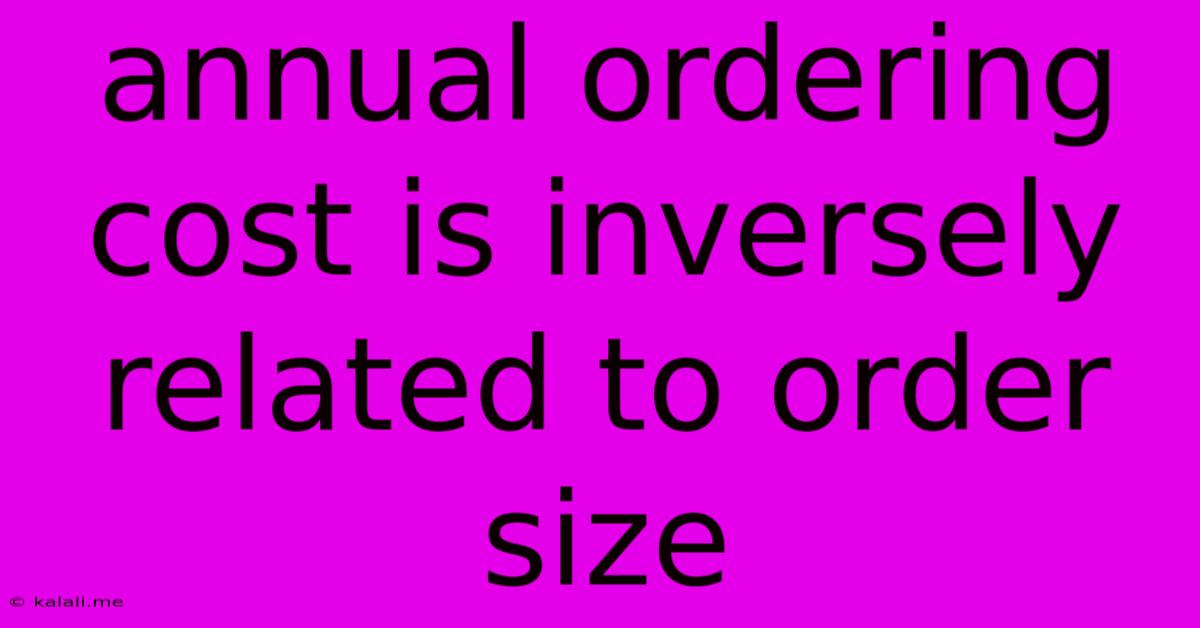Annual Ordering Cost Is Inversely Related To Order Size.
Kalali
Jun 13, 2025 · 3 min read

Table of Contents
The Inverse Relationship Between Annual Ordering Cost and Order Size: Optimizing Inventory Management
Understanding the relationship between annual ordering cost and order size is crucial for effective inventory management. This article will explore this inverse relationship, explaining its mechanics and highlighting its implications for businesses striving for optimal inventory levels and minimized costs. Efficient inventory control directly impacts profitability, so grasping this concept is essential for any business owner or supply chain manager.
What is Annual Ordering Cost?
Annual ordering cost refers to the total expense incurred by a business annually to place orders for inventory replenishment. This includes costs associated with:
- Processing orders: This encompasses administrative tasks, data entry, and communication with suppliers.
- Order placement fees: Some suppliers charge a fee for each order placed.
- Transportation costs: Getting the ordered goods to your warehouse or store incurs shipping, handling, and potentially customs fees.
- Inspection costs: Verifying the quality and quantity of received goods adds to the overall ordering cost.
The Inverse Relationship: Why Bigger Orders Mean Lower Costs (Usually)
The inverse relationship between annual ordering cost and order size suggests that as the quantity of goods ordered per order increases, the total annual ordering cost decreases. This is primarily because the fixed costs associated with placing an order are spread across a larger number of units. Let's illustrate with an example:
Imagine placing 10 orders of 100 units each versus placing 1 order of 1000 units. While the total units remain the same (1000), the number of orders is significantly different. The fixed costs associated with placing an order (processing, placement fees, initial transportation costs – note transportation per unit might increase with larger orders) will be ten times higher with the smaller, more frequent orders.
Factors Influencing the Inverse Relationship:
While the inverse relationship generally holds true, several factors can influence its strength and even potentially reverse it in certain situations:
- Economies of Scale: Larger orders often benefit from lower per-unit costs from suppliers, further reducing the overall ordering cost.
- Storage Costs: Increased order sizes lead to higher storage costs. This is the major factor that can counteract the benefits of fewer orders. There's an optimal order size balancing ordering and storage costs. This is where inventory management techniques become crucial.
- Transportation Costs: While initial transportation costs might be lower for fewer, larger orders, the per-unit cost might actually increase for exceptionally large shipments.
- Perishable Goods: For perishable or time-sensitive items, larger order sizes might lead to increased spoilage or obsolescence, negating the cost savings from fewer orders.
- Supplier Policies: Some suppliers may offer discounts for larger orders, further strengthening the inverse relationship.
Optimizing Order Size: The Economic Order Quantity (EOQ)
The concept of Economic Order Quantity (EOQ) helps businesses determine the optimal order size that minimizes the total inventory costs, which include both ordering and holding (storage) costs. The EOQ formula considers factors such as demand, ordering cost, and holding cost. It's a crucial tool for achieving optimal inventory management.
Conclusion:
The inverse relationship between annual ordering cost and order size is a fundamental principle of inventory management. However, businesses need to carefully consider all related costs, including storage and potential obsolescence, to determine the most economically advantageous order size. Utilizing tools like EOQ and sophisticated inventory management software can help businesses optimize this relationship and improve profitability by minimizing overall inventory costs. By understanding and effectively managing this relationship, businesses can streamline their supply chains and enhance their bottom line.
Latest Posts
Latest Posts
-
Which Of The Following Statements Are True Regarding Explicit Memory
Jun 14, 2025
-
Which One Of The Following Statements Is Incorrect
Jun 14, 2025
-
Which Of The Following Is Not An Agent Of Socialization
Jun 14, 2025
-
Common Factors Of 56 And 84
Jun 14, 2025
-
Lcm Of 9 6 And 3
Jun 14, 2025
Related Post
Thank you for visiting our website which covers about Annual Ordering Cost Is Inversely Related To Order Size. . We hope the information provided has been useful to you. Feel free to contact us if you have any questions or need further assistance. See you next time and don't miss to bookmark.